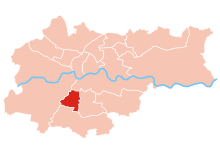Łagiewniki (Krakow)

Łagiewniki is a district of Krakow , in the administrative district IX Łagiewniki-Borek Fałęcki (until 2006 district Łagiewniki), about 5 km south of Kraków's Old Town , Poland .
history
The place was first mentioned in 1386 as Lagiwnik , although the surnames derived from the place name of the citizens of Kazimierz are mentioned: Mikush Lagofniczkone (?) In 1380 and Staschconi Lagiwinsky (1385). The name Łagiewniki is a service settlement name derived from the old profession of Cooper / Cooper / Cooper. The Old Polish Occupation Lagiewnik , plural: Lagiewniki dates back to the liquid measure łagiew (= German Lägel back - a standardized container / barrel). The Polish place name Łagiewniki means "[settlement of] Böttcher / Fassbinder / Küfer / Büttner / Lägelmacher".
From the mid-15th century, the place belonged to the Krakow castellans that a Vorwerk later built and a farm (16th century). Politically, the place was initially part of the Kingdom of Poland (from 1569 in the aristocratic republic of Poland-Lithuania ), Krakow Voivodeship , Szczyrzyc District.
When Poland was first partitioned , Łagiewniki became part of the new Kingdom of Galicia and Lodomeria of the Habsburg Empire in 1772 (from 1804). The Austrians built a branch of the Reichsstraße from Bielitz to Lemberg through Łagiewniki and Josefstadt ( Kaiser-Chaussee , Wiener Postroute , Wiener Haupt Comercial Strasse ), now part of the Zakopianka . From 1855 the village belonged to the Podgórze district .
In the years 1889-1893, the Convent of the Sisters of Our Lady of Mercy with the St. Joseph Chapel and the Image of the Merciful Jesus (1944), now an international sanctuary of the Divine Mercy .
From the turn of the 20th century slate and gypsum were mined there, which led to industrialization .
In 1900 the municipality of Łagiewniki had an area of 154 hectares with 80 houses and 761 inhabitants, all of whom were Polish-speaking and Roman Catholic .
After the end of World War I in 1918 and the collapse of the Austro-Hungarian monarchy , the village became part of Poland. In 1921 Łagiewniki had 1,149 inhabitants. It was incorporated into Krakow by German occupiers in 1941, which was only confirmed by the Polish administration on January 18, 1945.
Individual evidence
- ↑ a b Kazimierz Rymut , Barbara Czopek-Kopciuch: Nazwy miejscowe Polski: historia, pochodzenie, zmiany . 6 (L-Ma). Polska Akademia Nauk . Instytut Języka Polskiego, Kraków 2005, p. 261 (Polish, online ).
- ↑ Tomasz Jurek (editor): ŁAGIEWNIKI ( pl ) In: Słownik Historyczno-Geograficzny Ziem Polskich w Średniowieczu. Edycja elektroniczna . PAN . 2010-2016. Retrieved April 22, 2019.
- ↑ Cracovia Leopolis Andrzej Chilipalski, Którędy na Wiedeń?
- ↑ Ludwig Patryn (Ed.): Community encyclopedia of the kingdoms and countries represented in the Reichsrat, edited on the basis of the results of the census of December 31, 1900, XII. Galicia . Vienna 1907 ( online ).
- ↑ Główny Urząd Statystyczny: Skorowidz miejscowości Rzeczypospolitej Polskiej. Województwo krakowskie i Śląsk Cieszyński . Warszawa 1925, p. 31 [PDF: 41] (Polish, Woj.krakowskie i Sląsk Cieszynski miejscowości.pdf ).
Coordinates: 50 ° 1 ′ N , 19 ° 56 ′ E

